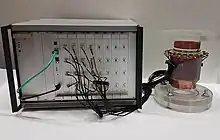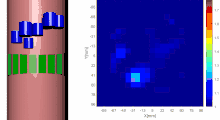

Electrical capacitance tomography (ECT) is a method for determination of the dielectric permittivity distribution in the interior of an object from external capacitance measurements. It is a close relative of electrical impedance tomography[2] and is proposed as a method for industrial process monitoring.
Although capacitance sensing methods were in widespread use the idea of using capacitance measurement to form images is attributed to Maurice Beck and co-workers at UMIST in the 1980s.[3]
Although usually called tomography, the technique differs from conventional tomographic methods, in which high resolution images are formed of slices of a material. The measurement electrodes, which are metallic plates, must be sufficiently large to give a measureable change in capacitance. This means that very few electrodes are used, typically eight to sixteen electrodes. An N-electrode system can only provide N(N−1)/2 independent measurements. This means that the technique is limited to producing very low resolution images of approximate slices. However, ECT is fast, and relatively inexpensive.
Applications
Applications of ECT include the measurement of flow of fluids in pipes[4] and measurement of the concentration of one fluid in another, or the distribution of a solid in a fluid. ECT enables the visualization of multiphase flow, which play an important role in the technological processes of the chemical,[5] petrochemical[6] and food[7] industries. Due to its very low spatial resolution, ECT has not yet been used in medical diagnostics. Potentially, ECT may have similar medical applications to electrical impedance tomography, such as monitoring lung function[8] or detecting ischemia or hemorrhage in the brain.[9]
See also
References
- ↑ Wanta, Damian; Smolik, Waldemar T.; Kryszyn, Jacek; Wróblewski, Przemysław; Midura, Mateusz (2022). "A Run-Time Reconfiguration Method for an FPGA-Based Electrical Capacitance Tomography System". Electronics. 11 (4): 545. doi:10.3390/electronics11040545.
- ↑ M Soleimani, W R B Lionheart, Nonlinear image reconstruction in electrical capacitance tomography using experimental data, Meas. Sci. Technol., 16, 2005, pp 1987–1996
- ↑ S M Huang, A Plaskowski, C G Xie and M S Beck, Capacitance-based tomographic flow imaging system, Electronics Letters, 24 (7), 1988, pp 418–19.
- ↑ Jaworski AJ and Dyakowski T, Application of electrical capacitance tomography for measurement of gas–solid flow characteristics in a pneumatic conveying system, Measurement Science and Technology, 12, 2001, pp 1109–19
- ↑ Rymarczyk, T.; Szumowski, J.; Adamkiewicz, P.; Tchórzewski, P.; Sikora, J. (2017). "Electrical Capacitance Tomography and Optical Detection in Quality Control System". Przegląd Elektrotechniczny. 93 (12): 213–216. doi:10.15199/48.2017.12.53. ISSN 0033-2097.
- ↑ York, T. A. (2001). "Status of electrical tomography in industrial applications". Journal of Electronic Imaging. 10 (3): 608. Bibcode:2001JEI....10..608Y. doi:10.1117/1.1377308.
- ↑ Beck, M.S.; Byars, M.; Dyakowski, T.; Waterfall, R.; He, R.; Wang, S.J.; Yang, W.Q. (1997). "Principles and Industrial Applications of Electrical Capacitance Tomography". Measurement and Control. 30 (7): 197–200. doi:10.1177/002029409703000702. S2CID 115040670.
- ↑ Wanta, Damian; Makowiecka, Oliwia; Smolik, Waldemar T.; Kryszyn, Jacek; Domański, Grzegorz; Midura, Mateusz; Wróblewski, Przemysław (2022). "Numerical Evaluation of Complex Capacitance Measurement Using Pulse Excitation in Electrical Capacitance Tomography". Electronics. 11 (12): 1864. doi:10.3390/electronics11121864.
- ↑ Jiang, Y. D.; Soleimani, M. (2019). "Capacitively Coupled Electrical Impedance Tomography for Brain Imaging". IEEE Transactions on Medical Imaging. 38 (9): 2104–2113. doi:10.1109/TMI.2019.2895035. PMID 30703015. S2CID 73448025.